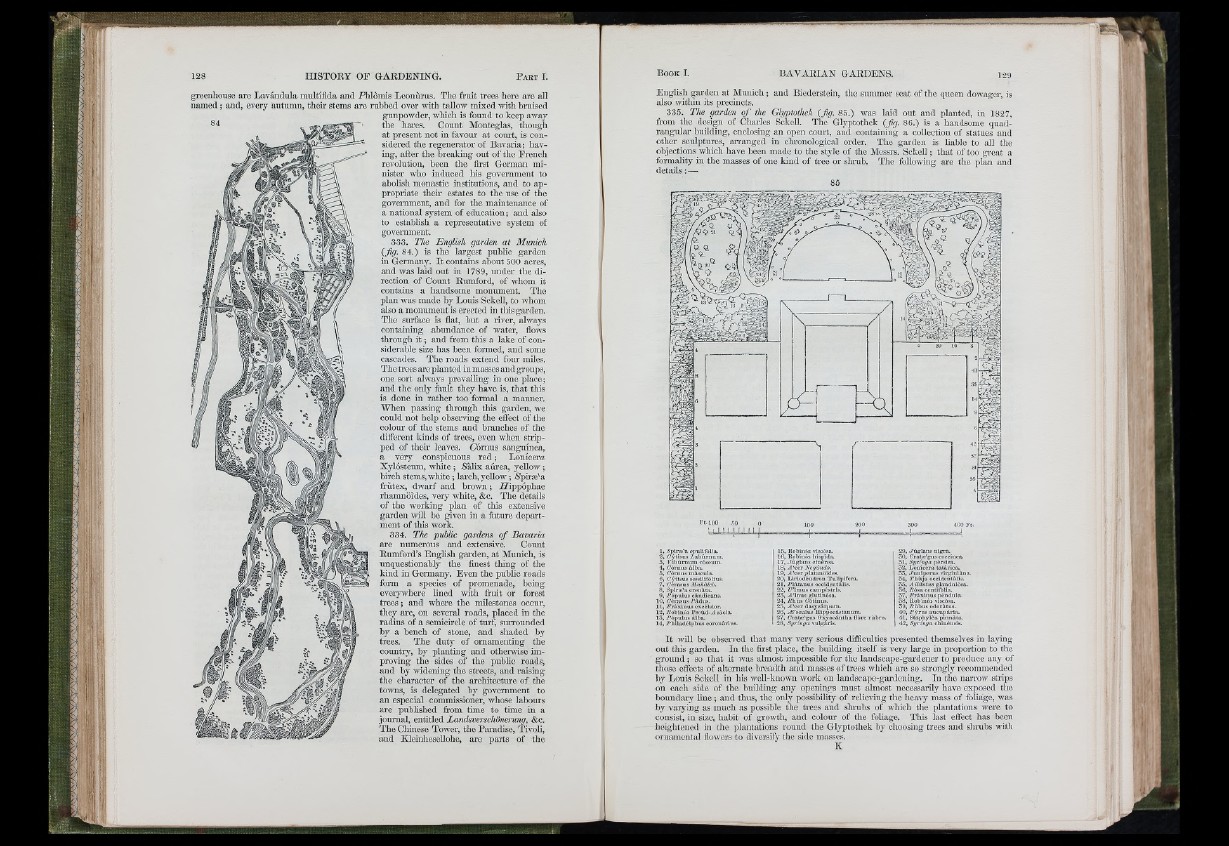
K<»:
1 4 'i
tl-'l
f e ; ,
l 4 ¡J
f e 'i
fe M
fe ?!
N Mi
I
i ' :
greenhouse are Lavandula multifida and Phlomis Leonurus. The fmit frees here are all
n am ed ; and, eveiy autumn, their stems are rubbed over Avith taUoAv mixed Avith bruised
gunpowder, which is found to keep aAvay
the hares. Count Monteglas, though
a t present not in favour at court, is considered
the regenerator of Bavaria; having,
after the breaking out of the Fi'ench
revolution, been the first German minister
who induced his government to
abolish monastic institutions, and to appropriate
their estates to the use of the
government, and for the maintenance of
a national system of education; and also
to establish a representative system of
government.
333. The English garden at Munich
(Jig. 84.) is the lai'gest public gai'den
in Germany. I t contains about 500 acres,
and was laid out in 1789, under the direction
of Count Rumford, of whom it
contains a handsome monument. The
plan Avas made by Louis Sckcll, to whom
also a monument is erected in this garden.
The surface is flat, but a river, always
containing abundance of Avater, floAvs
through i t ; and from this a lake of considerable
size has heen fonncd, and some
cascades. The roads extend four miles.
The trees are planted hi masses and gi-oups,
one sort ahvays prevaiHng in one place;
and the only fault they have is, that this
is done in rather too fonnal a manner.
When passing through this gai'den, we
could not help observing the effect of the
colour of the stems and branches of the
different kinds of trees, even when stripped
of their leaves. Cómus sanguínea,
a very conspicuous r e d ; Lonicera
Xylósteimi, w h ite; Nalix aúrea, yeUoAv;
birch stems, Avhite; larch, yellow; Npiríe'a
ñ'útex, dAvaif and broAvn; ífippóphae
rhamnoides, very white, &c. The details
of the Avorking plan of this extensive
garden will be given in a future department
of tliis work.
334. The public gardens o f Bavaria
are numerous and extensive. Count
Rumford’s English garden, at Munich, is
unquestionably the finest thing of the
kind in Germany. Even the pubhc roads
foi-m a species of promenade, being
everywhere lined with finiit or forest
fr'ees; and where the milestones occur,
they are, on several roads, placed in the
radius of a semicircle of turf, sun-ounded
by a bench of stone, and shaded by
frees. The duty of ornamenting the
country, by planting and otheiwise improving
the sides of the pubhc roads,
and by -widening the streets, and raising
the character of the architectm-e of the
toAATis, is delegated by government to
an especial commissioner, whose labours
are pubhshed from time to time in a
jomiial, entitled L-andsverschbnerung, See.
The Chinese Tower, the Pai'adise, Tivoh,
and Kleinhesehohe, are pai-ts of the
BAVARIAN GARDENS.
Enghsh g a rftn at Munich; and Bicderstein, the summer scat of the queen doAvager, is
also Avithin its precincts.
335. The garden o f the Glyptothek ( fg . 85.) Avas laid out and planted, in 1827,
from the design of Charles Sckcll. The Glyptothek ( fg . 86.) is a handsome quadrangular
building, enclosing an open court, and containing a collection of statues and
other sculptures, arranged in chronological order. The garden is hahle to all tho
objections Avhich have been made to the style of the Messrs. Sckcll; that of too great a
formality iu the masses of one kind of tree or shrub. The foUoAA-ing are the plan and
details: —
U J4 -
400 Ft.
1, S p i ra 'a miuHfòlia.
2, Cytisus 7 /abúnuini.
5, Kib iin ium ròscuin.
4, Córaus álba.
5, Córnus máscula.
10, Ccrasus Pàd u s.
11, P r á x in u s excélsior.
12, JiobUiia Pspùd-Acàcia.
13, Pó p u lu s .Alba.
14, Ph ilad c lp h u s eorouáriiis.
16, Roblnta hispid
17, J'ñglans cinórc...
18, A 'c e r A’egúndo.
19, A 'c erp la tan ü id es.
20, Liriodéndron Tulipíforr
21, Plábanus oecidgntális.
22, C'Imus cainpóstris.
23, A'ln u s glutinósa.
24, P h ù s Cótlnus.
25, A 'c er dasycárpum.
26, yíJ'sculus Uipiioeástanum.
27, Cratffi'gus Oxy ac án " -
28, S y rín g a vulgáris.
29, Jù g la n s nlgra.
30, Cratffi'gus tíoccínea.
31, S y rín g a pérsica.
32, Lonicera tatárica.
33, y im ip e ru s virginiána.
34, P h íy a occídcntális.
55, A ilá n lu s glandulósa.
56, P ò sa ccntifólía.
37, P r á x in u s péndula.
58, Rob in ia viscósa.
33, P íib u s odorátus.
40, P y r u s au cu p á ria .
41, Staphyléa pm n á ta.
42, S y rín g a cliinéusis.
I t will be observed that many very serious difficulties presented themselves in laying
out this gai-dcn. Iu the first place, the building itself is very large in proportion to the
g ro u n d ; so that it was almost impossible for the landscape-gai-dencr to produce any of
tliose effects of alternate breadth and masses of trees Avhieh are so strongly recommended
by Louis Sckcll in his Avell-knoAvn work on landscape-gai-dcuing. In the narroAv strips
on each side of the building any openings must almost necessarily have exposed the
boundary lin e ; and thus, the only possibility of relieving the heaA-y mass of foliage, was
b y varying as much as possible the trees and shrubs of which the plantations avcvc to
consist, in size, habit of growth, and colour of the foliage. This last effect has been
heightened in the plantations round the Glyptothek by choosing trees and shrubs vdl.h
ornamental floAvcrs to diversifv the side masses.
K